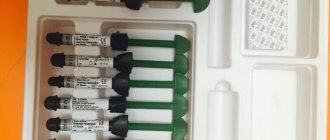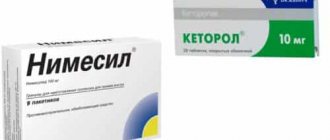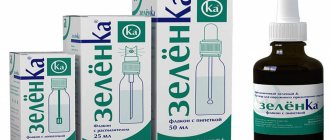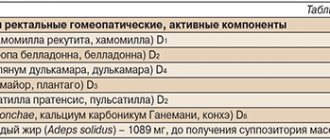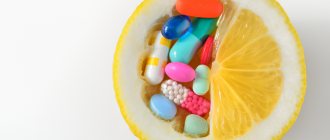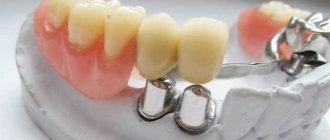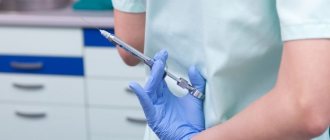Pharmacodynamics and pharmacokinetics
Pharmacodynamics
Anti-inflammatory non-steroidal drug from the sulfonamide . Has anti-inflammatory, antipyretic and analgesic effects.
Wikipedia indicates that the active substance acts as a blocker of type 2 cyclooxygenase, which is responsible for the biosynthesis of prostaglandins .
Pharmacokinetics
After administration, it is well absorbed from the intestines, reaching its highest concentration in the blood after 2-3 hours. Reaction with plasma proteins is 97.5%. The half-life is 4-5 hours. Quickly penetrates histohematic barriers.
Transformed in the liver under the influence of cytochrome P450 . The main active metabolite is hydroxynimesulide , which is excreted in bile in a glucuronidated form. It is excreted from the body mainly by the kidneys (about half of the dose taken).
Contraindications for Nimesil
Contraindications for use:
- history of hepatotoxic reactions caused by the active substance;
- bronchospasm , urticaria , rhinitis associated with the use of acetylsalicylic acid or other non-steroidal anti-inflammatory drugs in the anamnesis;
- concomitant use of drugs with potential hepatotoxicity;
- condition after coronary artery bypass surgery ;
- inflammatory bowel diseases ( ulcerative colitis , Crohn's disease ) in the acute stage;
- increased body temperature in infectious and inflammatory diseases;
- exacerbation of peptic ulcer , history of ulcer, perforation or bleeding in the digestive tract;
- a combination of bronchial asthma , nasal polyposis and intolerance to non-steroidal anti-inflammatory drugs;
- bleeding of cerebrovascular or other localizations; diseases accompanied by pathological bleeding;
- decompensated heart failure;
- severe blood clotting disorders;
- decompensated renal failure , hyperkalemia ;
- liver diseases;
- liver failure;
- alcoholism , drug addiction;
- pregnancy or lactation ;
- age under 12 years;
- hypersensitivity to the components of the drug.
The abstract recommends using the drug Nimesil with caution if there are
- severe forms type 2 diabetes mellitus arterial hypertension ;
- ischemic disease;
- heart failure;
- dyslipidemia;
- cerebrovascular diseases;
- peripheral arterial disease;
- elderly age;
- peptic ulcer in the past;
- infections associated with Helicobacter pylori;
- long-term previous use of non-steroidal anti-inflammatory drugs;
- decompensated somatic diseases;
- with smoking and concomitant treatment with anticoagulants, oral glucocorticosteroids, antiplatelet agents, selective serotonin reuptake blockers.
Use with caution
There are also pathologies in which adults should take Nimesil with caution:
- Diabetes mellitus type 2.
- Hypertension.
- Ischemic heart disease.
- Peripheral arterial diseases.
- Smoking.
- Taking non-steroidal anti-inflammatory drugs that reduce blood clotting, such as Heparin, Clopidogrel, etc., as well as hormonal glucocorticosteroids with an anti-inflammatory effect.
Indications for the use of Nimesil powder must be strictly observed.
Side effects
For toothache, headaches , colds, and menstruation, Nimesil is often used in medical practice, which can cause the following side effects:
- allergic reactions: sweating , rash , itching , erythema , anaphylactoid reactions , dermatitis , urticaria , erythema multiforme , angioedema , Stevens-Johnson syndrome , Lyell's syndrome ;
- hematopoietic disorders: eosinophilia , pacitopenia , anemia , thrombocytopenia , hemorrhagic syndrome , thrombocytopenic purpura ;
- visual disturbances: blurred vision;
- disorders of nervous activity: feelings of fear, dizziness , headache , nightmares, drowsiness , nervousness, encephalopathy ;
- circulatory disorders: hot flashes, tachycardia , arterial hypertension , sudden changes in blood pressure ;
- digestive system disorders: nausea, diarrhea , vomiting, flatulence , constipation , abdominal pain, gastritis , dyspepsia , tarry stools , stomatitis , bleeding from the digestive tract, gastric perforation or ulcer duodenal perforation or ulcer , hepatitis , cholestasis , jaundice , increased levels of liver enzymes;
- breathing disorders: shortness of breath , attacks of bronchial asthma ;
- general disorders: asthenia , general malaise, hypothermia ;
- disorders of the genitourinary system: renal failure , hematuria , urinary retention, dysuria , oliguria, interstitial nephritis ;
- other disorders: hyperkalemia .
Instructions for use of Nimesil (Method and dosage)
Instructions on how to dilute Nimesil
The drug in powder (granules) is placed in a glass and diluted in approximately 100 ml of water. The prepared solution cannot be stored; it must be taken as soon as possible. There is a common question about what kind of water to dissolve the powder in. The instructions recommend dissolving the medicine in warm, boiled water.
Nimesil powder, instructions for use
The medicine (after preparation) is taken orally, 1 sachet twice a day, after meals. The maximum duration of treatment is two weeks.
To reduce the risk of side effects, it is recommended to use the lowest effective dosage for the shortest possible period of time.
Instructions for use of Nimesil for children
Nimesil (as well as tablets or ointment based on nimesulide) is prohibited for use in children under 12 years of age. Children 12-18 years old are recommended to take standard doses.
Instructions on how to take granules for people with kidney disorders
There is no need to change the dose in persons with mild to moderate renal impairment.
How to take Nimesil powder for elderly patients
When treating elderly patients, the need to change the daily dosage is determined by the doctor, taking into account the possibility of interaction with other medications taken.
In the head and neck area, due to the peculiarities of the anatomical structure of the nerve plexuses, pain often occurs instantly. According to the definition from Collier's Encyclopedia, pain is an unpleasant sensation or suffering caused by irritation of specific nerve endings in damaged or already damaged tissues of the body. The biological significance of pain is that it serves as a warning signal and forces people to reduce physical activity during injury or illness, which facilitates the healing process.
All human inflammatory diseases, one way or another, are accompanied by pain. Among the main diseases of the oral cavity, periodontal diseases have held a leading position for many years. The main percentage of periodontal tissue pathology is due to inflammatory-destructive diseases, a smaller part is due to destructive periodontal pathology, such as recession. It is known that the cause of the development of periodontitis is the introduction of a number of pathogenic bacteria, which results in an inflammatory process that leads to the destruction of the supporting-retaining apparatus of the tooth. While the cause of recession is often a traumatic factor against the background of anatomical predispositions - a thin biotype of the gum and bone substrate. Incorrect movements of the brush when brushing teeth, bad habits and structural features of the soft tissues of the vestibule of the oral cavity can act as a traumatic factor [1, 2].
Since “treatment” is a system of measures aimed at restoring health, preventing complications of the disease and eliminating manifestations of the disease that are painful for the patient, the surgical stage is often the main one in an integrated approach to periodontal diseases.
Pain, tissue swelling, increased temperature of the damaged area - all this can occur at various stages of the course of inflammatory-destructive periodontal diseases. Often the above symptoms occur during an exacerbation of the disease, i.e. abscess formation. Then the inclusion of non-steroidal anti-inflammatory drugs (NSAIDs) in complex therapy is beyond doubt, while in the chronic course of the disease patients often do not present such complaints.
As mentioned above, the cause of recession often lies in the anatomical features of the structure of the soft tissues of the vestibule. Then, to prevent progression of gum loss and root exposure, laxative operations are recommended. Elimination of the traumatic effect of cords, for example frenulectomy or vestibuloplasty, is a fairly common operation. Direct surgical treatment of recessions themselves is also becoming increasingly popular, although it does not yet allow achieving lasting results, including aesthetic ones.
When performing any surgical intervention on the tissues of the maxillofacial area, and periodontal tissue in particular, the postoperative period is almost always accompanied by “side effects,” including pain. This is one of the indications for prescribing NSAIDs as symptomatic therapy in order to facilitate the processes of tissue repair and regeneration [3].
NSAIDs were discovered about 150 years ago and have since become widespread in medicine. The mechanism of action of NSAIDs is based on inhibition of cyclooxygenase (COX) synthesis. When tissue is damaged, be it mechanical impact or microbial invasion, a cascade of reactions develops in the body, as a result of which COX is activated, an enzyme that regulates the formation of prostaglandins (PG), mediators of edema, inflammation and pain. However, along with the positive properties of NSAIDs, side effects were soon discovered, such as reactions from the mucous membrane of the gastrointestinal tract, cardiovascular system, and kidneys.
Only after the discovery in the early 90s of the twentieth century of two isoforms of COX—structural (COX-1) and inducible enzyme (COX-2)—it became possible to explain the side effects on the body [5, 6].
The mechanism of nonselective COX inhibition is key to understanding the adverse effects that occur. It is the effect on both isoforms (COX-1 and COX-2) that is the risk of side effects, since COX-1, being a structural enzyme, regulates the production of PGs involved in ensuring the normal (physiological) functional activity of cells.
From the point of view of practical medicine, the most interesting among NSAIDs are modern drugs that can suppress predominantly COX-2, an enzyme involved in the synthesis of PG in the area of inflammation [4].
Such a drug is nimesil, a non-steroidal anti-inflammatory drug of the sulfonanilide class, presented on the Russian market. The main active ingredient, nimesulide, was first registered in 1980, and already in 1985 it was approved for use in Italy and since then has been one of the most frequently prescribed NSAIDs [7].
The advantage of the drug nimesil is its ability to inhibit COX-2 to a greater extent, thereby exhibiting analgesic and anti-inflammatory effects, while the effect on COX-1 occurs to a minor extent. This explains the minimal side effects when taking nimesulide compared to NSAID analogues [8, 9]. Of no less importance is the antioxidant property of the main active ingredient, nimesulide, as well as the ability to inhibit metalloproteases, which has an indirect effect on the processes of regeneration and repair of cartilage and bone tissue [6].
The dosage form of the drug nimesil is presented in the form of granules (Fig. 1)
Figure 1. Release form of the drug nimesil. for the preparation of a suspension for oral administration, is well absorbed, the maximum concentration in the blood plasma is achieved on average after 2-3 hours.
Having strong anti-inflammatory and analgesic properties, the drug nimesil is widely used in many countries around the world [10].
The purpose of our clinical observation was to determine the effectiveness and feasibility of using the drug nimesil in the postoperative period during various surgical interventions on periodontal tissues.
Clinical observation was carried out in the department of periodontology of the Federal State Budgetary Institution "Central Research Institute of Dentistry and Maxillofacial Surgery" of the Ministry of Health and Social Development of the Russian Federation. 23 patients of both sexes aged from 18 to 55 years without severe somatic pathologies and a history of allergic reactions were selected to participate in the study.
Depending on the type of surgical intervention, all patients were divided into groups (Fig. 2):
Figure 2. Distribution of patients into groups depending on surgical interventions.
— patients after flap operations (operation in the area of no more than 4 teeth) — 10 people (Fig. 3);
Figure 3. Flap surgery. Stage of detachment of the mucoperiosteal flap.
— patients after directed tissue regeneration (NTR, no more than 2 teeth) — 5 people (Fig. 4);
Figure 4. Stage of guided tissue regeneration.
- patients after opening periodontal abscesses (if there is no more than one abscess) - 8 people (Fig. 5).
Figure 5. Periodontal abscess.
We deliberately did not include in the observation patients after laxative operations on soft tissues: vestibuloplasty, frenulectomy, as well as operations to eliminate gum recession, since this should be the topic of a separate clinical observation or study due to the anatomical features of the operated areas and their high degree of vascularization .
All patients after surgery were prescribed nimesil in the dosage recommended by the manufacturer, 1 sachet (100 mg) 2 times a day after meals for 4 days.
Our recommendations for the duration of taking the drug nimesil were based on the fact that, due to the characteristics of the reactions occurring in the body against the background of inflammation, the peak of patient complaints about swelling and especially pain occurs, as a rule, on the 3rd day after the intervention. To minimize the severity of pain, we recommended starting the drug immediately after surgery to avoid the accumulation of products of COX-2 activation, namely PG, mediators of edema and pain [4].
We used a Numeric Rating Scale (NRS) to determine pain intensity. It is designed to determine only one property of pain - its intensity and consists of 11 points - from 0 (“no pain”) to 10 (“worst pain imaginable”). It should be noted that although all index assessments of pain intensity are approximate and subjective, a more accurate method of determination has not yet been established. The advantages of the NRS method are that it does not require the patient to have clear vision, does not require a pen and paper, and does not require the patient to be able to use them. The scale can be used even when communicating with a patient by telephone.
However, determining the intensity of the pain symptom alone would not allow us to evaluate the full spectrum of action of the drug nimesil, so in our study we also paid attention to swelling of the soft tissues in the surgical area as one of the informative indicators of the degree of inflammation.
Since we did not find a suitable index to determine the degree of tissue swelling, we developed a digital scale similar to the NRS. Unfortunately, this scale also does not make it possible to obtain objective data, but it allows, albeit roughly, to describe the degree of tissue swelling. The measurement range was selected from 0 to 2. In the absence of edema, the value was defined as 0; with swelling of soft tissues only in the area of the intervention - 1; with significantly pronounced edema, as well as its spread to other anatomical structures - 2.
results
Clinical examination and questioning of patients was carried out on the 1st, 3rd and 7th days after surgery.
When examined on the 1st day, complaints of pain in patients after flap operations and after opening single abscesses ranged from “weak” to “moderate”, while in patients after NTR the pain intensity was slightly higher ( Fig. 6).
Figure 6. Pain intensity on the 1st, 3rd and 7th days after surgery when taking the drug nimesil.
However, upon examination on the 3rd day, there was a significant decrease in the intensity of pain symptoms in patients with abscesses and in the group of patients after flap surgery; the average for both groups remained in the range of “mild” pain, despite the expected peak of pain. In the group of patients after NTR, the decrease in the intensity of the pain reaction occurred a little slower, and the average value was at the level of “moderate” sensations.
When examining and interviewing patients on the 7th day after the intervention, pain was completely absent in all 3 groups, despite stopping taking the drug nimesil on the 4th day after surgery.
As for determining the degree of soft tissue swelling, we obtained the following indicators.
Maximum soft tissue swelling was recorded on the 1st day after the intervention in all groups of patients (Fig. 7).
Figure 7. The degree of swelling of soft tissues on the 1st, 3rd and 7th days when taking the drug nimesil. But, as in the case of determining the pain symptom in the group of patients after NTR, the degree of tissue swelling was slightly higher. Most likely, such data are associated with the traumatic nature of the intervention and once again indicate the absolute need to prescribe NSAIDs in the postoperative period.
By the 3rd day, in all groups there was a stable decrease in soft tissue swelling and in some cases (8 patients) its almost complete absence.
When surveyed, the majority of study participants - 20 people - noted the rapid onset of the analgesic effect, approximately 15-20 minutes after taking the drug; the remaining 3 participants could not accurately determine the time of onset of the effect, but, according to them, it did not exceed 30 minutes. The strength and duration of action of the drug nimesil were sufficient, which allowed patients not to increase the recommended dose and frequency of administration.
It should be noted that no side effects were observed in any of the patients.
Thus, in the course of our clinical observation, it was found that nimesil has proven itself well as an analgesic and anti-inflammatory drug for the management of the postoperative period during surgical interventions on periodontal tissues. The use of the drug nimesil allows patients to comfortably endure the period after surgery.
Overdose
Signs of overdose:
- vomit;
- drowsiness;
- apathy;
- nausea;
- epigastric pain.
The development of gastrointestinal bleeding is possible. In especially rare cases, there is a possibility of increased blood pressure, acute kidney failure, respiratory depression, anaphylactoid reactions , and coma .
Treatment of overdose is symptomatic. There is no selective antidote. If no more than 4 hours have passed since the overdose, it is necessary to rinse the stomach and take enterosorbents, for which activated carbon or an osmotic laxative is used. Monitoring the functioning of the kidneys and liver is indicated.
Interaction
When used simultaneously with glucocorticosteroids, the risk of ulcers or bleeding from the stomach and intestines increases.
When used with antiplatelet agents and selective serotonin reuptake inhibitors, the likelihood of gastric or intestinal bleeding also increases.
Anti-inflammatory nonsteroidal drugs may enhance the effects of anticoagulants, so this combination is not recommended for persons with severe coagulation disorders. If this combination cannot be avoided, careful monitoring of blood clotting parameters is necessary.
Anti-inflammatory non-steroidal drugs can weaken the effects of diuretics.
Nimesulide is able to temporarily reduce the evacuation of sodium and potassium under the influence of Furosemide and thereby weaken the diuretic effect of the latter. It must also be remembered that such co-prescription of drugs requires caution in persons with impaired renal and cardiac function.
Anti-inflammatory non-steroidal drugs may weaken the effect of antihypertensive drugs. In persons with compensated renal failure, with the simultaneous administration of ACE blockers, angiotensin receptor antagonists of the second type or agents that suppress cycloxygenase, progression of deterioration of renal function and the development of reversible acute renal failure .
Anti-inflammatory non-steroidal drugs reduce the clearance of lithium, which causes an increase in the level of the latter in the blood.
When prescribing Nimesil less than a day before or after using Methotrexate, caution must be exercised, since in such cases the content of methotrexate in the blood and its toxic effects may increase.
Nimesulide can stimulate the nephrotoxicity of cyclosporines.
Use in children and pregnant women
Nimesil is not used in children under twelve years of age. Therefore, in case of intoxication in children, accompanied by fever and pain, it is recommended to use other drugs.
During pregnancy, the use of Nimesil is strictly prohibited. When using the drug, the development of the fetus is inhibited and the cardiovascular system does not develop. If you use Nimesil immediately before childbirth, it is possible that the expectant mother will experience bleeding and bleeding in the baby’s brain.
special instructions
Side effects can be minimized by using the lowest effective dosage of the drug in a minimally short course.
Nimesil powder medicine should be used with caution in persons with a history of gastrointestinal diseases, since exacerbation of these diseases is possible.
Since the drug is partially evacuated by the kidneys, its dosage for persons with impaired renal function should be reduced depending on the volume of urine excreted.
When the first symptoms of liver damage appear (itching, yellowing of the skin, nausea, abdominal pain, vomiting, dark urine, increased liver transaminases), you must stop taking the medication and consult a doctor.
If any signs of visual impairment appear during drug therapy, the patient should be examined by an ophthalmologist.
Nimesil can provoke fluid retention in the body, so people with high blood pressure and heart disease should use the drug with extreme caution.
If symptoms of an acute respiratory infection of a viral nature occur during drug therapy, Nimesil should be stopped.
Nimesil should not be used simultaneously with other anti-inflammatory non-steroidal drugs.
Nimesulide can change the characteristics of platelets , so care must be taken when using the drug in patients with hemorrhagic diathesis . It is worth remembering that the medicine does not replace the preventive effect of acetylsalicylic acid for diseases of the circulatory system.
"Nimesulide"
Available in the form of tablets, powder and gel. Tablets are sold in packs of 10, 20 or 30 pieces. You need to take 1 tablet 2 times a day. It is strictly forbidden to exceed the indicated dosage. The gel is used externally only.
Metrogyl Denta or Cholisal, which is better?
- Nimesulide is prescribed to reduce fever and relieve inflammation.
The drug helps with the following diseases:
- – all types of arthritis;
- – increased body temperature;
- – ARVI, cold;
- – headache and toothache;
- – pain syndrome after a bruise;
- – osteochondrosis and osteoarthrosis;
- – all types of inflammation (ligaments, tendons, soft tissues).
Even with long-term use, the drug does not cause addiction. Exceeding the dosage prescribed by the doctor is strictly prohibited. Otherwise, dangerous side reactions of the body may occur.
Elderly patients should exercise special caution when taking this medication. It is better not to use the medication without a doctor’s testimony. It is not allowed to take Nimesulide together with alcoholic beverages.
Nimesil's analogs
Level 4 ATX code matches:
Nimulid
Diacerein
Aponil
Chondroitin sulfate
Sigan
Don
Nimegesic
Artiflex
Nimika
Artron Hondrex
Artron Flex
Artron Complex
Arthroker
Arthrodarin
Nemulex
Chondroitin
Glucosamine Hydrochloride
Glucosamine
Nimid Forte
Nimid
The price of Nimesil analogues is usually lower than that of the described product. Below are medications with identical composition that can replace Nimesil:
- Ameolin (tablets)
- Aponil (tablets)
- Affida Fort (granules for suspension)
- Mesulide (tablets)
- Nise (tablets, suspension)
- Negan (tablets)
- Nimegesik (tablets, suspension)
- Nimesin (tablets)
- Nimesulide (tablets, gel)
- Nimid (tablets, granules)
- Nimujet (injection solution)
- Nimulid (tablets, suspension, injection solution, gel)
- Nimuspaz (tablets)
- Pansulide (tablets)
- Remesulide (tablets)
- Sulidin (gel)
- Taro-Sanovel (tablets)
Nise or Nimesil - which is better?
Nise and Nimesil are analogues. The main difference between the drugs is that the first is available in the form of a gel for topical use and tablets, and the cost of Nise is an order of magnitude lower. The choice should be made based on the doctor’s recommendations, type of indication and economic considerations.
What are the similarities and what are the differences?
Nimesulide or Nimesil - are they the same thing or not? "Nimesil" and "Nimesulide" have a common active substance - nimisulide. Therefore, these drugs can be called identical. Medicines quickly and effectively eliminate pain, relieve inflammation and normalize body temperature.
However, there are some differences between the drugs, which play an important role when choosing a more suitable drug.
What is the difference between Nimesulide or Nimesil? The main difference between medications is the form of release:
- One of them is available only in granules.
- The second can be purchased in the form of gel, tablets and granules.
Indications for use also have some differences:
- Nimesil has a more limited list of indications.
- "Nimesil" has more side effects, and it must be taken within the strict limits of the prescribed dosage.
- In addition, Nimesulide has a wide list of restrictions on its use.
This must be taken into account when purchasing.
The most significant difference is the price:
- "Nimesil" can be bought for 200 rubles.
- The cost of "Nimesulide" is 60 rubles.
Most patients prefer the cheaper option.
The difference in price is due to the fact that Nimesulide is produced in Russia, and Nimesil in European countries.
Nimesil for children
Nimesil (as well as tablets or ointment based on nimesulide ) is prohibited for use in children under 12 years of age. The instructions for the drug for children indicate that the method of using Nimesil (how to apply and how to dilute the powder) is no different for other age groups. How to use the powder, how to dilute Nimesil in powder, as well as how to drink Nimesil in powder, is described in the section “Instructions for use of Nimesil (Method and dosage)”
Is it possible to give Nimesil to children with fever?
This medicine is not the drug of choice for reducing body temperature, although it has a mild antipyretic effect. Nimesil should be used only for the purpose of relieving mild and moderately mild pain. Prohibited for the treatment of children under 12 years of age.
Nimesil during pregnancy and lactation
Nimesil, like other drugs of the NSAID class, is contraindicated for use during pregnancy and lactation. The active substance of the drug - nimesulide - negatively affects the course of pregnancy and the embryo, as it can lead to premature closure of the ductus arteriosus, hypertension in the pulmonary artery system, impaired renal function, an increased risk of bleeding, decreased contractility of the uterus, and the occurrence of peripheral edema.
Nimesil is contraindicated during pregnancy
Also, it is worth considering that Nimesil is not recommended for use by women who are planning to become pregnant, as the drug can negatively affect female fertility.
Reviews about Nimesil
For toothache and other types of pain (associated with injuries, algodismenorrhea ), Nimesil powder is widely used. Reviews of its use among patients are positive and there is little evidence of the development of undesirable effects.
Reviews from doctors about Nimesil also well characterize the drug as a remedy that effectively relieves pain of a traumatic nature and pain localized in the musculoskeletal system. However, it is worth remembering that in a number of countries nimesulide are completely prohibited due to increased hepatotoxicity.
Is Nimesil an antibiotic or not?
A common question among patients. Nimesil is not an antibiotic and does not have an antibacterial effect. Its main effects: antipyretic, analgesic, anti-inflammatory.
Reviews from doctors and people
- Svetlana Kharkovaya, dentist. Toothache can be quite severe and should not be tolerated. Taking Nimesil can help the patient. Of course, it is very important to pay attention to possible side effects and contraindications - not everyone can take the medicine. In some cases, I recommend Nimesil to relieve pain after treatment or tooth extraction. And I can say with confidence that during my long practice, no one complained that Nimesil did not help or that it made me feel ill.
- Ekaterina Menshikova. Nimesil became a real salvation for me at the time when I was treating my teeth. The pain was unbearable, both before visiting the doctor and in the first days after treatment (two teeth had to be removed due to inflammation). The advantage of this medicine is that it is easily diluted and begins to act very quickly. Of course, there are cheaper analogues - but I don’t want to experiment, since Nimesil has already been tested by time.
Nimesil price, where to buy
The price of Nimesil powder (9 sachets) in Russia is about 300 rubles. For comparison, the price of 1 sachet of Nimesil is 30-40 rubles.
The average price in Ukraine for drug No. 1 is approximately 10 hryvnia, and the price of a package containing 30 sachets fluctuates around 300 hryvnia.
How much does the analogue of Nimesil Nise cost?
The cost of this drug in Russia in the form of 100 mg tablet No. 20 is about 200 rubles, and the ointment of the same name 1% 20 grams will cost 200-250 rubles.
- Online pharmacies in RussiaRussia
- Online pharmacies in UkraineUkraine
- Online pharmacies in KazakhstanKazakhstan
ZdravCity
- Nimesil granules for Prig Susp.
for internal approx. 100 mg 30 pcs. Laboratorios Menarini/Fine Foods & Pharmaceuticals RUB 753 order
Pharmacy Dialogue
- Nimesil (pack 2g No. 9)Berlin-Chemie AG/Menarini
RUB 443 order
- Nimesil (pack 2g No. 30)Berlin-Chemie AG/Menarini/FineFoods
RUB 1,038 order
- Nimesil (pack No. 1)Berlin-Chemie AG/Menarini
51 RUR order
show more
Pharmacy24
- Nimesil 2 g N30 powder Laboratorios Menarini S.A./Fine Foods and Pharmaceuticals N.T.M.S.P.A., Spain/Italy
279 UAH.order
PaniPharmacy
- Nimesil Nimesil granules for the preparation of suspension 100 mg 2 g No. 30 Spain, Lab. Menarini
314 UAH. order
show more
Release form, composition
The drug Nimesil is available in a dosage form, a powder for the preparation of a suspension, which is intended for oral administration. It has a light green color, coarse grain, and an orange scent. The main active component of the drug is nimesulide, its content in 1 sachet of powder is 100 mg. The drug also contains additional compounds, which include:
- Sucrose.
- Orange flavor.
- Ketomacrogol.
- Anhydrous citric acid.
- Maltodextrin.
Nimesil powder is packaged in aluminum foil bags of 2 g each. A cardboard pack contains 9, 15 or 30 bags.

